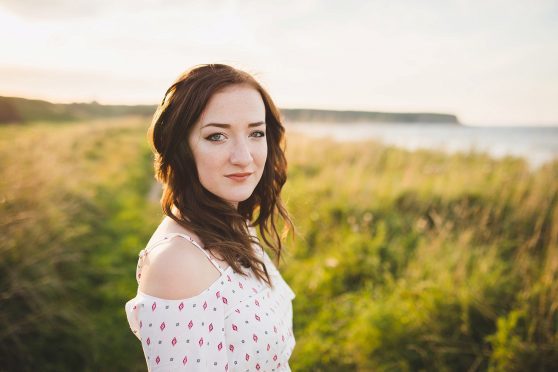Eighteen-year-old Iona Fyfe, from Huntly in Aberdeenshire, classes herself as a traditional folk artist.
She is moving her way up the folk music scene after studying Scots song and traditional music at the Royal Conservatoire of Scotland. During her last year, she was awarded a classical voice scholarship at the north-east of Scotland music school in Aberdeen.
HOW DID YOU FIRST BECOME INTERESTED IN MUSIC?
It was through the Traditional Music and Song Association (TMSA) and the Buchan Heritage Society that I first became interested in music and the traditional arts.
I first competed in the Doric poetry section at Keith Festival when I was five or six then began to play piano and sing. I’m so grateful to have been exposed to some of the country’s finest traditional folk and ballad singers from a young age.
YOU ARE A SEMI-FINALIST AT THE BBC RADIO SCOTLAND YOUNG TRADITIONAL MUSICIAN OF THE YEAR 2017, HOW DID THAT COME ABOUT?
Each year, Hands Up for Trad and the TMSA release applications and traditional musicians will apply and send in some clips of them playing and around 13 get selected each year.
It is very similar to the BBC Radio 2 Young Folk Award competition which I was part of in 2015, but Young Trad is restricted to musicians who live in Scotland. I am very lucky to be one of 13 chosen for this year.
WHY DO YOU LIKE FOLK MUSIC?
I simply enjoy music because it brings people together. Music and folk music truly transcend generation and background.
Folk music truly is the music of the people – historically and culturally informed, raw music which tells a story and has a narrative.
I find it difficult to find other genres which engage the interests of the people as much as folk music. Music and folk music truly transcend generation and background.
WHAT HAS BEEN YOUR FAVOURITE EXPERIENCE WHILE PERFORMING?
There has been so many special moments I’ve experienced but I think my favourite performance experience was this time the band were playing in a beautiful Italian theatre.
I was singing quite a humorous unaccompanied song, and I began to grin and laugh inside uncontrollably and then began to laugh properly uncontrollably. I totally broke down in fits of laughter and nobody really knew why.
The song was in Doric vernacular so the audience didn’t quite understand it but everyone just laughed and clapped. Not my finest moment but an irrationally funny and memorable moment.
TELL ME ABOUT YOUR BAND?
The band really differs depending on where and when and who is free, but the general line-up is Luc McNally, a guitarist and singer originally from the north-east of England, Charlie Grey, a fiddler from Inverness, Callum Cronin, a very funky double-bass player from Callander and Ross Miller, a piper, whistle player and singer from Linlithgow, who often guests with the band.We have a good interaction.
We often use online resources to practise up in our own time, then we come together to practise or arrange our songs and sets. Because we often are in different places doing different things, we’re pretty good at sorting logistics and through the web.
DO YOU WRITE YOUR OWN SONGS?
I’m not too good at writing my own songs to be honest. I’ve written some for university coursework but my strength lies in rewriting text and creating new melodies for text, for example Pride of Aberdeen, a song featured in Even in Winter, a fundraising album for Aberdeen Food Banks.
I took the text from the Greig-Duncan Folk Song Collection and reworded it. I think it really represents the process of folk song arranging and the changes texts and song go through to fit a current sound.
WHAT IS BALLAD SINGING AND WHY IS IT DIFFERENT?
I’ve come to learn that ballad singing and singing with a band are two completely separate things – that sometimes can combine. Ballad singing is conventionally unaccompanied, it is about the story, the delivery of the story and the interpretation of the text.
Ninety-one out of 305 of Francis James Child’s Child Ballads were of Aberdeenshire origin, so I’m so lucky to have come from a place so deeply rooted in traditional song and culture.
Ballad competitions such as the ones hosted by the TMSA are judged and this is where I learned or heard a lot of the songs I now sing. Arranging songs for band performance is a different art form from learning and interpreting a ballad for solo unaccompanied use.
WHAT ARE YOUR AIMS FOR THE FUTURE?
I’d love to travel to more far-off places and perform at festivals and tour about. It would be great to spend some time in research also and spend some time living back in Aberdeenshire after university in 2019.
I think I’d like to finally release a debut album in 2019 perhaps. I feel I am still too young now.My band EP East has had a lovely reception and it was great fun creating it.
The CD can be physically and digitally purchased from Bandcamp and iTunes.
https://ionafyfemusic.bandcamp.com
On Saturday, October 1, Iona is singing at the TMSA Concert at Cookney Village Hall. It starts at 7.30pm and includes singers such as Geordie Murison, John Dickson and Dennis Shepherd. See www.facebook.com/ Traditional-Music-and-Song-Association-of-Scotland-TMSA-Aberdeen-136166253116943 or www.tmsa.org.uk for more details.
